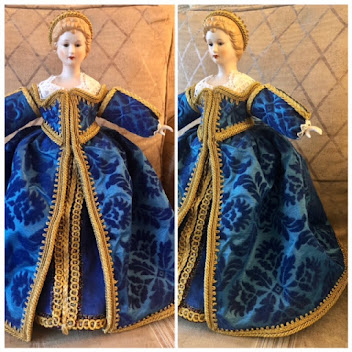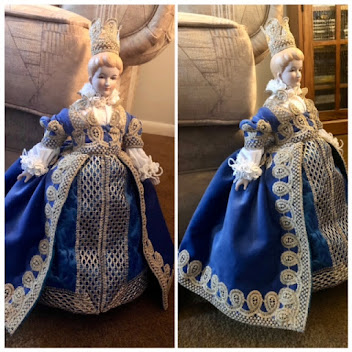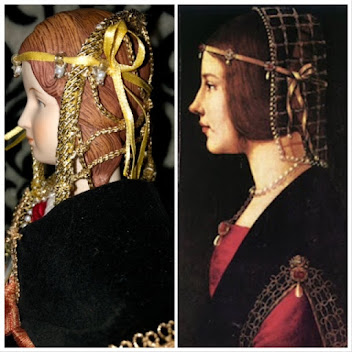I did receive some embroidery books as of recent that have been very influential. Exploring Elizabethan embroidery by Dorothy Clarke, has been a very useful guide with working with motifs and design on the Elizabethan embroidery. I have had this book for sometime and have enjoyed working some of the designs from it. Many of the designs in the first book are more display panels that could be used in many ways but they do not show as much applications in the first book. There is a sweet bag that I do want to make as well as some pincushions and the rest of them or more like needlework display panels that you would frame. There is a great middle section of the book that shows several different needleworkers, and their final designs. There are not any examples to these designs anywhere else in the book. But it shows what you can do with your skills and the projects that you could create in the future.
Discovering that there is actually a series of books on various different authors. The second in the
series is called Elizabethan Needlework Accessories by Sheila Marshall. This book outlines more detail in regards to more intricate designs, there is bookcovers, handbags, needle cases and several different designs with many more practical applications of this style of embroidery. This book is very heavy on projects. There are at least twice as many projects in the second book as there were in the first book. So you really are able to take the instructions and make many beautiful creations.
The third book in the series is called Festive Elizabethan Creations by Shirley Holdaway. There is a lot of interesting information in regards to necessities needed to create types of embroidery how do you frame and find fabrics. How to care for your embroidery after it is done. So there is a little bit more information in the third series compared to the first two books there is only one or two pages in the first two books that talk about tools, care, and use of embroidery. All three books have fantastic diagram showing how to create various different stitches and a fax using the designs from the books. This third book in the series also has color charts from three major thread companies. So if you want to follow the design examples in the book to the exact color. You are able by following the thread numbers recommended for each flower and design element.
There is even a brief history given about this style of embroidery in the first book. What I like is that this series allows anyone to try this style of embroidery. It opens up the intricacies, makes them relatable. Shows how to do the stitches via diagrams and instructions. And allows one to make anything from a small needlecase up to a much larger display panels for the home that could be framed. As far as true historical accuracy, these designs were created by an modern artist. So therefore if you wanted to create an arts and sciences project you would have to make sure the design you're creating is something from an extent piece. Or found an image from an existing needlework in a museum and draft a pattern from it. The examples in the book or a way of getting great practice and learning the stitches. And allow someone to create beautiful objects and accessories for their home to represent the Elizabethan needlework style of the 16th century. However it's best to take the knowledge gained and create a project from an existing museum piece for SCA arts and sciences projects.
Regards,
Mairin
Monday, November 17, 2014
Subscribe to:
Post Comments (Atom)
Replica 1560's Venetian Italian Fashion Doll

Replica 1560 French Fashion Doll

Tudor Q and A
What is a Tudorosity?
A mashed combination of the words Tudor and Curiosity to create the word Tudorosity. Tudorosities is the plural form and the deffinition is as follows.
Tudorosity- an desire to learn or know anything about the Tudor dynasty associated with years 1405 through 1603.
Most people ask my why I make the Tudor garb ?
I find the clothing of this era not only beautiful but also challenging to sew. There is much more care and purpose put into making garments and wearing garments in the Tudor Era. I love the look of Tudor so much I wanted to explore the way clothes were made back then and the subtle changes in fashion and styles of time.
How did you get started in this interesting hobby?
I started with art first, I love to draw, paint, and sculpt all the traditional fine arts. So being able to draw helps me visualize the looks I want to create in my garb. History has always been a huge interest of mine and I've had a knack for sewing since I was 7 years old. It all started with doll clothes and I learned cross stitch embroidery from my grandmother when I was little. I am self taught sewer, crochet, knitting, embroidery and tatting. My methods are learned from books mainly and there is still so much more to learn.
What is my favorite outfit and why?
It would be like picking a favorite out of one of my future children, its impossible. I love all my gown creations and really like the distinct differences in all the styles clothing I make for the Tudor Era.
Do you make the whole outfit including hat, shoes, and undergarments?
I do have a goal of making a complete Tudor from the skin out. As of right now I make 90% of my gowns and accessories. The shoes and stockings, are bought online and the petticoats are a close reproduction but not made by me. .
How long does it take to make a gown?
It all depends on the type of gown. The making relies on the time period and class of the design. Generally if I work on it 8 hours a day on a sewing machine it will take 3 days to get the basics and another 5 days to do finish hand-sewing details and beading. So a week to a week and a half if working on it steady for that amount of time. I work a full-time job so it does take longer than a week to complete. I put over 40-100 hours per outfit depending on its complexity, its like its own full time job of sorts.
Do you make renaissance clothing for sale or custom orders?
No, due to new employment and changes in my lifestyle. Unfortunately, I have no time to support sewing for others. Though I recommend sewing lessons for those adventurous few. There are many fine folks who make and sell historical clothing. I suggest guidance with sew from many fine historical enthusiastic costumers out on the internet.
How long have you been making these elaborate costumes?
I have been in the Society of Creative Anachronism coming up on my 18th year. Active since 2004 working at demonstrations and volunteering when I could between working and other life's distractions. I really concentrated on Tudor sewing in 2007 and worked with patterns to learn proper fabrics, techniques, fit, and silhouette. I really enjoy the eras transition from a medieval form fitting layered cotterdie to the boned Tudor kirtle and then to structured Elizabethan clothing.
A mashed combination of the words Tudor and Curiosity to create the word Tudorosity. Tudorosities is the plural form and the deffinition is as follows.
Tudorosity- an desire to learn or know anything about the Tudor dynasty associated with years 1405 through 1603.
Most people ask my why I make the Tudor garb ?
I find the clothing of this era not only beautiful but also challenging to sew. There is much more care and purpose put into making garments and wearing garments in the Tudor Era. I love the look of Tudor so much I wanted to explore the way clothes were made back then and the subtle changes in fashion and styles of time.
How did you get started in this interesting hobby?
I started with art first, I love to draw, paint, and sculpt all the traditional fine arts. So being able to draw helps me visualize the looks I want to create in my garb. History has always been a huge interest of mine and I've had a knack for sewing since I was 7 years old. It all started with doll clothes and I learned cross stitch embroidery from my grandmother when I was little. I am self taught sewer, crochet, knitting, embroidery and tatting. My methods are learned from books mainly and there is still so much more to learn.
What is my favorite outfit and why?
It would be like picking a favorite out of one of my future children, its impossible. I love all my gown creations and really like the distinct differences in all the styles clothing I make for the Tudor Era.
Do you make the whole outfit including hat, shoes, and undergarments?
I do have a goal of making a complete Tudor from the skin out. As of right now I make 90% of my gowns and accessories. The shoes and stockings, are bought online and the petticoats are a close reproduction but not made by me. .
How long does it take to make a gown?
It all depends on the type of gown. The making relies on the time period and class of the design. Generally if I work on it 8 hours a day on a sewing machine it will take 3 days to get the basics and another 5 days to do finish hand-sewing details and beading. So a week to a week and a half if working on it steady for that amount of time. I work a full-time job so it does take longer than a week to complete. I put over 40-100 hours per outfit depending on its complexity, its like its own full time job of sorts.
Do you make renaissance clothing for sale or custom orders?
No, due to new employment and changes in my lifestyle. Unfortunately, I have no time to support sewing for others. Though I recommend sewing lessons for those adventurous few. There are many fine folks who make and sell historical clothing. I suggest guidance with sew from many fine historical enthusiastic costumers out on the internet.
How long have you been making these elaborate costumes?
I have been in the Society of Creative Anachronism coming up on my 18th year. Active since 2004 working at demonstrations and volunteering when I could between working and other life's distractions. I really concentrated on Tudor sewing in 2007 and worked with patterns to learn proper fabrics, techniques, fit, and silhouette. I really enjoy the eras transition from a medieval form fitting layered cotterdie to the boned Tudor kirtle and then to structured Elizabethan clothing.
Replica 1490 Milan Italian Fashion Doll

Based on art by Giovanni Ambrogio
O’Kealy Heraldry


No comments:
Post a Comment